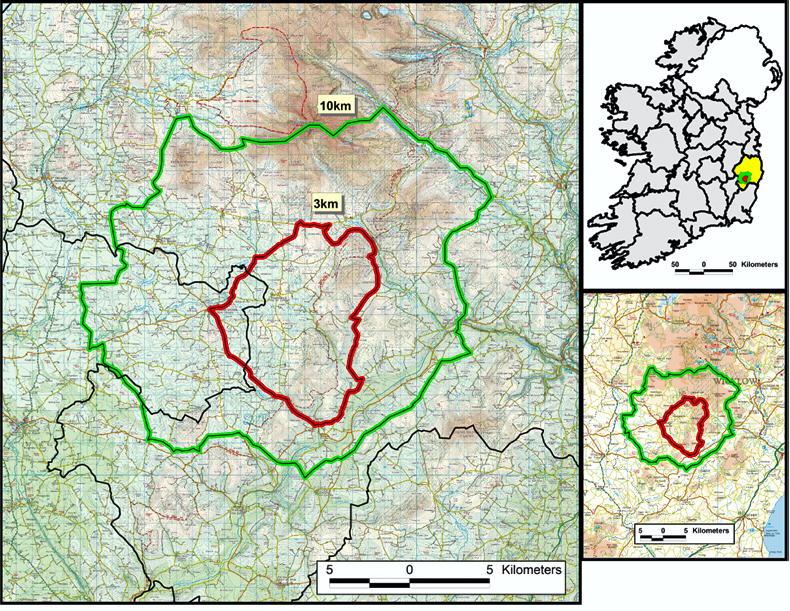The highly pathogenic avian influenza H5N8 strain has been found in a Wicklow flock of free-range turkeys.
The entire flock has been killed and a bird flu protection zone set up within a 3km radius of the flock by the Department of Agriculture. A wider 10km surveillance zone has also been set up.

A bird flu protection zone has been set up within a 3km radius of the flock by the Department of Agriculture.
All poultry holdings within the 3km and 10km zones will be assessed and procedures put in place to control movements of live poultry, other captive birds, hatching and table eggs, used litter, manure and slurry from poultry holdings.
Avian influenza H5N8 has been identified in wild birds in Cork, Limerick, Kildare, Wicklow, Mayo and Monaghan.
Results of pathogen testing on the Wicklow birds are expected within days.
Risk
There is no evidence of risk associated with consumption of poultry meat or poultry meat products.
Although the H5N8 subtype can cause serious disease in poultry and other birds, no human infections with this virus have been reported worldwide, so the risk to humans is considered to be very low.
However, members of the public are advised not to handle sick or dead wild birds and to report sick or dead wild birds to the regional veterinary office or contact the DAFM disease hotline on 1850 200456.
An early warning system is in place with Birdwatch Ireland, the National Parks and Wildlife Service and the National Association of Regional Game Councils with regard to surveillance for signs of disease in wild birds.
About avian influenza H5N8
Highly pathogenic avian influenza H5N8 has been confirmed in wild birds in six counties in Ireland. These findings pose a risk to all poultry flocks and captive birds and, by extension, the poultry industry.
Outbreaks of highly pathogenic avian influenza have also been identified in poultry flocks in the United Kingdom, Netherlands, Germany, France, Denmark, Sweden, Poland, Croatia and Ukraine in recent weeks.
The Department urges all poultry keepers, regardless of flock size, to strictly adhere to biosecurity measures to help reduce mitigate the risk of the virus.
Extra enhanced biosecurity measures must be implemented in flocks of 500 birds or more.
Poultry flock owners should report any disease suspicion to their nearest Department regional veterinary office.
Clinical signs of highly pathogenic avian influenza
Depression.Loss of appetite and excessive thirst.Cessation of egg laying.Respiratory signs (coughing, sneezing).Ruffled feathers.Nervous signs (drooping wings, dragging legs, twisting of the head and neck, circling, complete paralysis).Swelling and blue discoloration of combs and wattles.Blue discoloration of shanks.Diarrhoea.Sudden death.Mortality rates up to 100%.
The highly pathogenic avian influenza H5N8 strain has been found in a Wicklow flock of free-range turkeys.
The entire flock has been killed and a bird flu protection zone set up within a 3km radius of the flock by the Department of Agriculture. A wider 10km surveillance zone has also been set up.

A bird flu protection zone has been set up within a 3km radius of the flock by the Department of Agriculture.
All poultry holdings within the 3km and 10km zones will be assessed and procedures put in place to control movements of live poultry, other captive birds, hatching and table eggs, used litter, manure and slurry from poultry holdings.
Avian influenza H5N8 has been identified in wild birds in Cork, Limerick, Kildare, Wicklow, Mayo and Monaghan.
Results of pathogen testing on the Wicklow birds are expected within days.
Risk
There is no evidence of risk associated with consumption of poultry meat or poultry meat products.
Although the H5N8 subtype can cause serious disease in poultry and other birds, no human infections with this virus have been reported worldwide, so the risk to humans is considered to be very low.
However, members of the public are advised not to handle sick or dead wild birds and to report sick or dead wild birds to the regional veterinary office or contact the DAFM disease hotline on 1850 200456.
An early warning system is in place with Birdwatch Ireland, the National Parks and Wildlife Service and the National Association of Regional Game Councils with regard to surveillance for signs of disease in wild birds.
About avian influenza H5N8
Highly pathogenic avian influenza H5N8 has been confirmed in wild birds in six counties in Ireland. These findings pose a risk to all poultry flocks and captive birds and, by extension, the poultry industry.
Outbreaks of highly pathogenic avian influenza have also been identified in poultry flocks in the United Kingdom, Netherlands, Germany, France, Denmark, Sweden, Poland, Croatia and Ukraine in recent weeks.
The Department urges all poultry keepers, regardless of flock size, to strictly adhere to biosecurity measures to help reduce mitigate the risk of the virus.
Extra enhanced biosecurity measures must be implemented in flocks of 500 birds or more.
Poultry flock owners should report any disease suspicion to their nearest Department regional veterinary office.
Clinical signs of highly pathogenic avian influenza
Depression.Loss of appetite and excessive thirst.Cessation of egg laying.Respiratory signs (coughing, sneezing).Ruffled feathers.Nervous signs (drooping wings, dragging legs, twisting of the head and neck, circling, complete paralysis).Swelling and blue discoloration of combs and wattles.Blue discoloration of shanks.Diarrhoea.Sudden death.Mortality rates up to 100%. 






 This is a subscriber-only article
This is a subscriber-only article










SHARING OPTIONS: